Cambridge Silicon Radio BSMAN BlueSlim Modules BSMAN1, BSMAN3 and BSMAN4 User Manual User Guide
Cambridge Silicon Radio Ltd BlueSlim Modules BSMAN1, BSMAN3 and BSMAN4 User Guide
Contents
User Guide
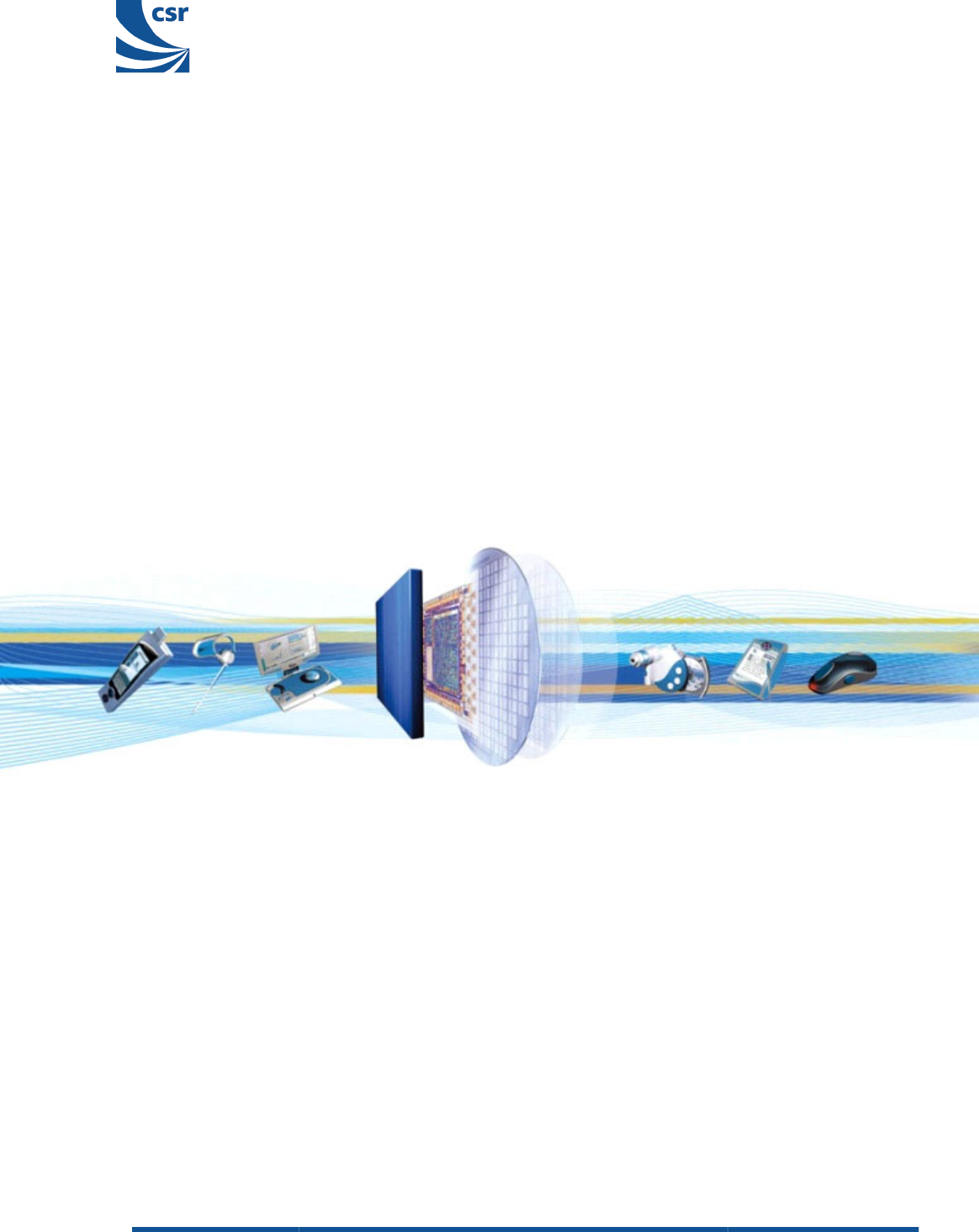
_äìÉ`çêÉ∆
_äìÉpìáíÉ»
User Guide
Issue 3
CSR
Cambridge Science Park
Milton Road
Cambridge CB4 0WH
United Kingdom
Registered in England 3665875
Tel.: +44 (0)1223 692000
Fax.: +44 (0)1223 692001
www.csr.com
CS-118613-UGP3 © Cambridge Silicon Radio Limited 2000-2008
This material is subject to CSR’s non-disclosure agreement

Document History
Revision Date Change Reason
212 MAR 08 Original publication of this document.
313 NOV 08 Section on Command Line Tools transport options added. Minor text corrections.
Document History
CS-118613-UGP3 © Cambridge Silicon Radio Limited 2000-2008
This material is subject to CSR’s non-disclosure agreement Page 2 of 27
_äìÉ`çêÉ
∆
=_äìÉpìáíÉ» User Guide

Trademarks, Patents and Licences
Unless otherwise stated, words and logos marked with ™ or
®
are trademarks registered or owned by CSR plc or
its affiliates. Bluetooth
®
and the Bluetooth logos are trademarks owned by Bluetooth SIG, Inc. and licensed to CSR.
Other products, services and names used in this document may have been trademarked by their respective owners.
The publication of this information does not imply that any licence is granted under any patent or other rights owned
by CSR plc.
CSR reserves the right to make technical changes to its products as part of its development programme.
While every care has been taken to ensure the accuracy of the contents of this document, CSR cannot accept
responsibility for any errors.
CSR’s products are not authorised for use in life-support or safety-critical applications.
Refer to www.csrsupport.com for compliance and conformance to standards information.
Trademarks, Patents and Licences
CS-118613-UGP3 © Cambridge Silicon Radio Limited 2000-2008
This material is subject to CSR’s non-disclosure agreement Page 3 of 27
_äìÉ`çêÉ
∆
=_äìÉpìáíÉ» User Guide

Contents
1 Introduction ..................................................................................................................................................... 6
2 System Requirements .................................................................................................................................... 7
2.1 Operating System .................................................................................................................................. 7
2.2 Software Required ................................................................................................................................. 7
3 Install BlueSuite .............................................................................................................................................. 8
4 Install a USB Driver ...................................................................................................................................... 10
4.1 Configuring the USB INF File For Your Device ................................................................................... 10
4.1.1 Verifying VID and PID Operating System Support ................................................................. 10
4.1.2 Adding the VID and PID ......................................................................................................... 10
4.2 Change the USB Driver ....................................................................................................................... 11
5 Firmware Overview ....................................................................................................................................... 13
5.1 Firmware File Formats ......................................................................................................................... 13
5.2 Persistent Store ................................................................................................................................... 13
5.3 Firmware Build Types .......................................................................................................................... 14
5.4 Upgrading Firmware ............................................................................................................................ 14
6 Getting Started .............................................................................................................................................. 15
6.1 Exploring the Bluetooth Stack .............................................................................................................. 15
7 BlueSuite Programs ...................................................................................................................................... 16
7.1 Transport Options for Command Line Tools ........................................................................................ 16
7.2 BlueFlash ............................................................................................................................................. 17
7.2.1 User Interface ......................................................................................................................... 17
7.2.2 Troubleshooting BlueFlash .................................................................................................... 19
7.2.3 BlueFlashCmd ........................................................................................................................ 19
7.3 PSTool ................................................................................................................................................. 20
7.3.1 PsCli ....................................................................................................................................... 20
7.3.2 Documentation ....................................................................................................................... 20
7.4 BlueTest ............................................................................................................................................... 20
7.4.1 BlueTest3 ............................................................................................................................... 20
7.4.2 Documentation ....................................................................................................................... 20
7.5 BTCli .................................................................................................................................................... 21
7.5.1 Example Usage ...................................................................................................................... 21
7.6 RFCli .................................................................................................................................................... 21
7.7 BCFMRadio ......................................................................................................................................... 22
7.8 BCFMCli .............................................................................................................................................. 22
7.9 E2Util ................................................................................................................................................... 22
7.10 E2BlueCmd .......................................................................................................................................... 22
7.10.1 EEPROM File Formats ........................................................................................................... 22
7.11 DFU Wizard ......................................................................................................................................... 23
7.12 DFU Babel ........................................................................................................................................... 23
7.12.1 Upgrading The USB to SPI Converter Firmware ................................................................... 23
7.13 DFU ToolTips ....................................................................................................................................... 24
7.14 DFU Tools ............................................................................................................................................ 24
8 TrueTest Toolkit ............................................................................................................................................ 25
9 Document References .................................................................................................................................. 26
Terms and Definitions ............................................................................................................................................ 27
Contents
CS-118613-UGP3 © Cambridge Silicon Radio Limited 2000-2008
This material is subject to CSR’s non-disclosure agreement Page 4 of 27
_äìÉ`çêÉ
∆
=_äìÉpìáíÉ» User Guide

List of Figures
Figure 3.1 Full Installation of BlueSuite .............................................................................................................. 8
Figure 3.2 Additional Tasks Dialogue ................................................................................................................. 9
Figure 4.1 Changing the Driver ........................................................................................................................ 12
Figure 7.1 BlueFlash User Interface in Windows Vista .................................................................................... 17
Figure 7.2 A DFU ToolTip ................................................................................................................................ 24
List of Tables
Table 5.1 Firmware File Formats ..................................................................................................................... 13
Table 7.1 Command Line Transport Options ................................................................................................... 16
Table 7.2 Explanation of the BlueFlash User Interface .................................................................................... 18
Table 7.3 Example Connections and How to Make Them with BTCli .............................................................. 21
Contents
CS-118613-UGP3 © Cambridge Silicon Radio Limited 2000-2008
This material is subject to CSR’s non-disclosure agreement Page 5 of 27
_äìÉ`çêÉ
∆
=_äìÉpìáíÉ» User Guide

1 Introduction
_äìÉpìáíÉ» is a _äìÉ`çêÉ
∆
development suite designed to help with your _äìÉíççíÜ
∆
wireless technology development
program.
BlueSuite contains:
■
Graphical and command-line applications to configure, test and program the BlueCore device in your
design.
■
The qêìÉqÉëí» Toolkit, a set of libraries for developing production test applications for your BlueCore
enabled devices.
■
Device drivers to communicate with BlueCore.
■
Documentation to help development.
This user guide explains:
■
The minimum system requirements in order to be able to run Bluesuite. See Section 2.
■
How to install BlueSuite Section 3 and Section 4.
■
The features and functions Bluesuite contains. See Section 7.
Introduction
CS-118613-UGP3 © Cambridge Silicon Radio Limited 2000-2008
This material is subject to CSR’s non-disclosure agreement Page 6 of 27
_äìÉ`çêÉ
∆
=_äìÉpìáíÉ» User Guide

2 System Requirements
Minimum system requirements for BlueSuite are:
■
Pentium processor based personal computer
■
64MB of RAM
■
20MB of available hard disk space
2.1 Operating System
BlueSuite can be used on the following operating systems:
■
Microsoft Windows XP Service Pack 2 and later (not x64)
■
Microsoft Windows Vista (not x64)
■
Microsoft Windows 2000 Service Pack 3 and later (only for versions of BlueSuite prior to 2.0)
See the release notes for testing information and detailed operating system requirements.
2.2 Software Required
Your copy of BlueSuite comes with:
■
Microsoft .NET Framework Version 2.0 Redistributable Package
■
Visual C++ 2005 Redistributable Package
The BlueSuite installer automatically installs these packages on your computer if they are missing.
System Requirements
CS-118613-UGP3 © Cambridge Silicon Radio Limited 2000-2008
This material is subject to CSR’s non-disclosure agreement Page 7 of 27
_äìÉ`çêÉ
∆
=_äìÉpìáíÉ» User Guide
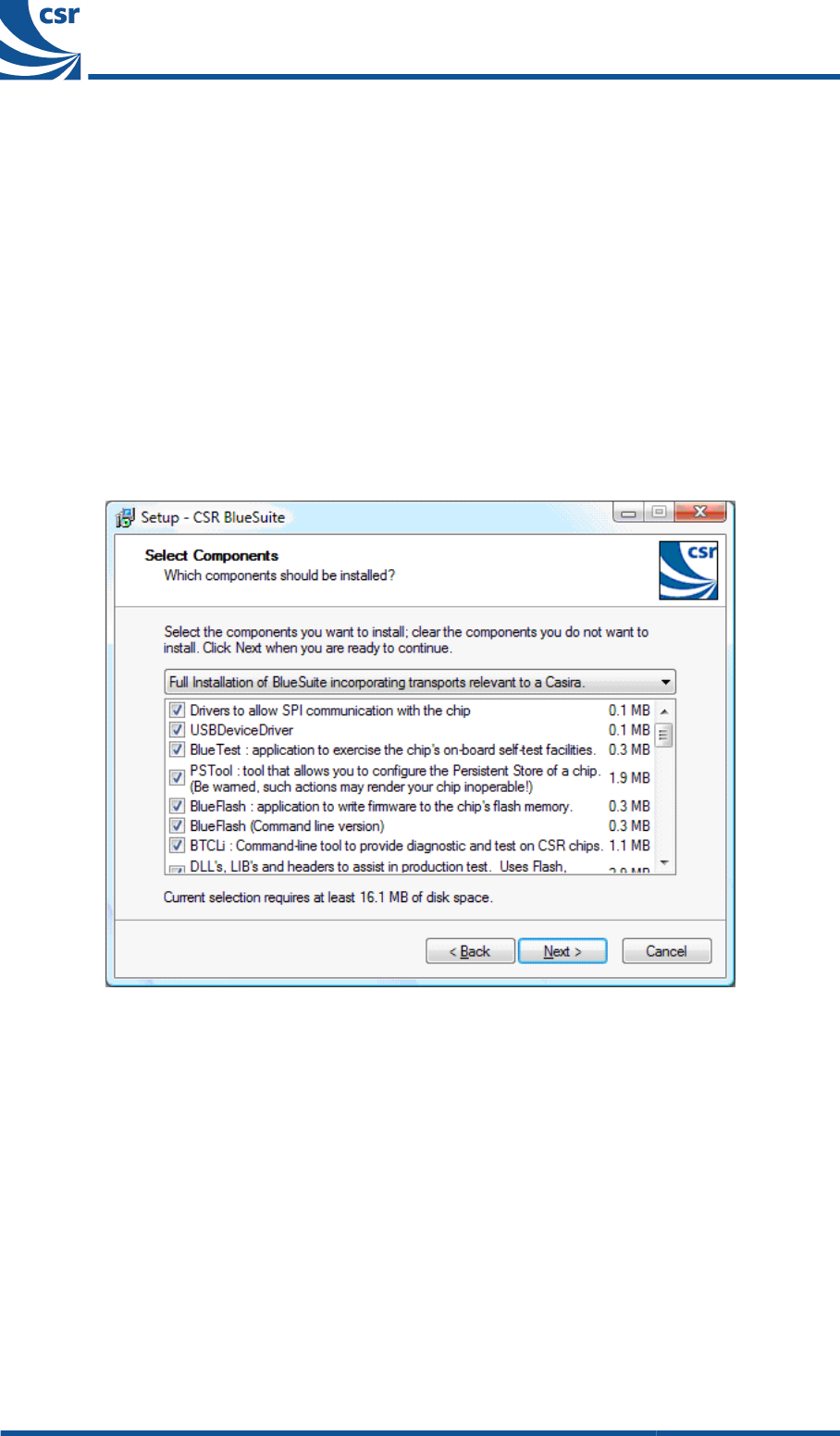
3 Install BlueSuite
Note:
A bug in BlueSuite version 1.23 means that even if a later version of BlueSuite is installed, the version information
for the USB driver may still indicate 1.23. If version 1.23 has previously been installed on the PC, unplug all
CSR hardware, make sure you have the latest version of BlueSuite installed and run
usbpurger
from the
BlueSuite installation directory. When a CSR BlueCore is plugged in, the Hardware Wizard prompts you for
drivers.
Run the BlueSuite installer and follow the instructions displayed by the setup wizard.
By default the installer does a full installation, as shown in Figure 3.1. If you do not want to install all of the possible
components, be sure that you install:
■Drivers to allow SPI communication with the chip
. You will need these to back-up your BlueCore device.
■USBDeviceDriver
if you want to connect your device to your computer's USB port.
■DLL's, LIB's and headers to assist in production test
if you want to do production testing.
Figure 3.1: Full Installation of BlueSuite
When you get to the Additional Tasks dialogue in Figure 3.2, you have to select the default debug transport. This
configures the default behaviour of the BlueSuite programs. You can change this after installation by changing
environment variable
SPITRANS
to
LPT
or
USB
. See Section 7.1
Install BlueSuite
CS-118613-UGP3 © Cambridge Silicon Radio Limited 2000-2008
This material is subject to CSR’s non-disclosure agreement Page 8 of 27
_äìÉ`çêÉ
∆
=_äìÉpìáíÉ» User Guide
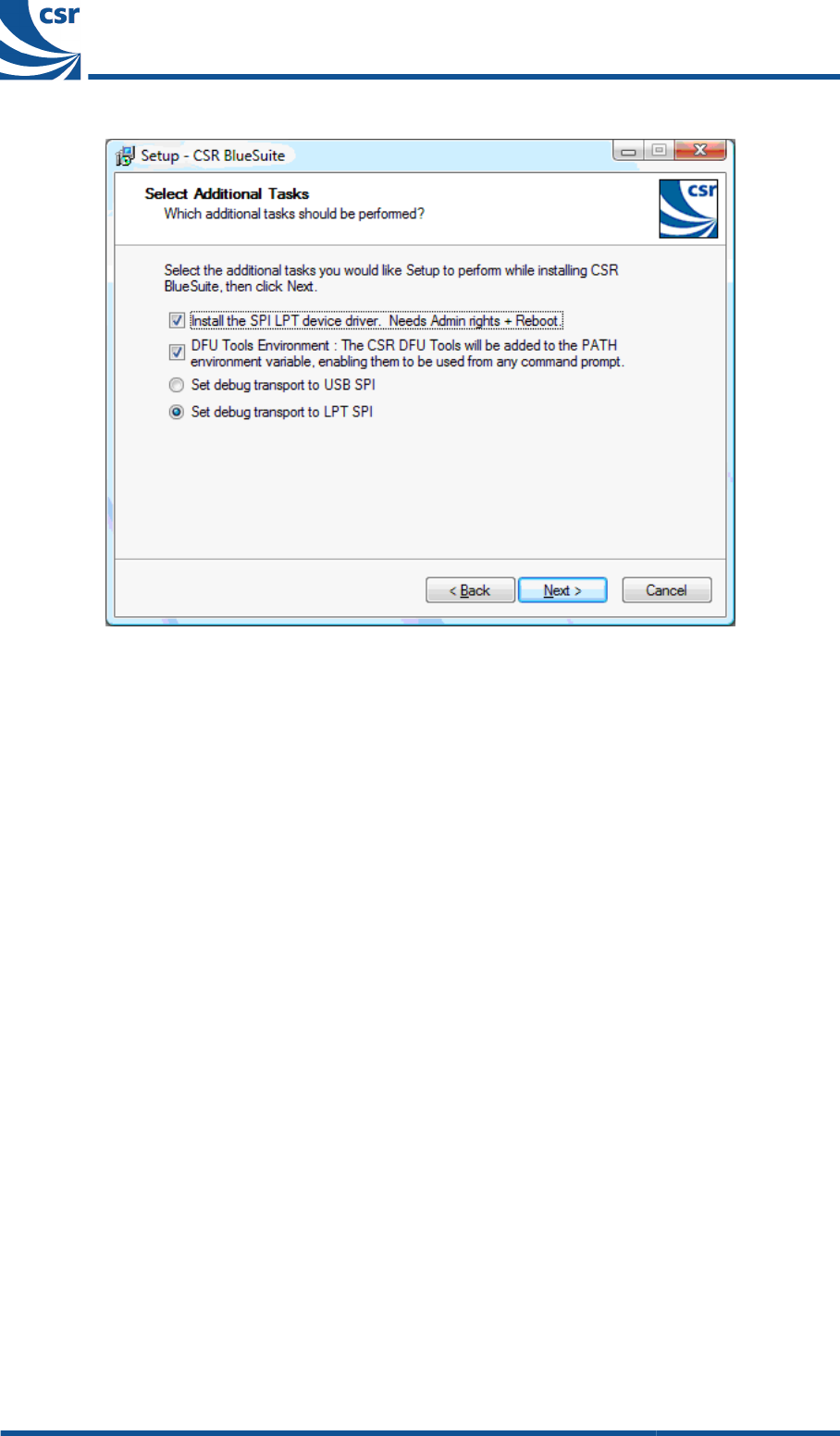
Figure 3.2: Additional Tasks Dialogue
Install BlueSuite
CS-118613-UGP3 © Cambridge Silicon Radio Limited 2000-2008
This material is subject to CSR’s non-disclosure agreement Page 9 of 27
_äìÉ`çêÉ
∆
=_äìÉpìáíÉ» User Guide

4 Install a USB Driver
BlueCore devices can be used with a USB host interface. The USB host interface is not a debugging interface and
can be used by end users or in production modules. If you want to use the USB host interface to BlueCore, you must
first configure your BlueCore for the USB host interface, and then install a USB device driver.
4.1 Configuring the USB INF File For Your Device
If you are developing a USB device containing a BlueCore chip, during your development you can use the CSR USB
driver.
When a USB device is plugged into a computer, it sends identifying information to the computer so the computer
can decide which driver to use with it. Two of the pieces of information sent are the Vendor ID (VID) and the Product
ID (PID).
If your device's VID and PID are not currently supported by the CSR USB Driver, you must add them to the driver
INF (information) file so Windows recognises that the CSR USB driver will work for your device.
This chapter describes how to check the file to determine if your device is supported, and if not, how to add the
device.
4.1.1 Verifying VID and PID Operating System Support
The CSR USB INF file is
CSRBlueCoreUSB.inf
, by default located in
Program Files/CSR/BlueSuite/drivers
. Open the file with a text editor, and search for your device
VID and PID. E.g. for a standard example Bluetooth device:
%Example.DeviceDesc%=CSRBC.Inst.NTx86.5.1,
USB\VID_1234&PID_5678 ; Example USB Device VID&PID
If your device is present in
CSRBlueCoreUSB.inf
skip Section 4.1.2 as the CSR USB driver supports your
device.
4.1.2 Adding the VID and PID
The example below adds a device with a VID of
0x1234
and a PID of
0x5678
with a name of
Generic Device
. All PIDs and VIDs in an INF file are in hexadecimal.
This procedure adds the device to all supported operating systems of the INF file. While just the operating system
of interest could be modified, CSR recommend you add the information to all three possible operating systems, for
completeness.
CSR recommend you add the device information after the final line in each section.
1. Create a backup copy of
CSRBlueCoreUSB.inf
.
2. Uncheck the
Read-only
attribute of the file before you edit it.
3. Add the device to the Windows 2000 section of the file:
;
; Windows 2000
; [CSR]
...
%MOTION2DFU.DeviceDesc%=CSRBC.Inst,
USB\VID_10ab&PID_1006 ; MOTION BC04 Device VID&PID DFU
%GENERIC.DeviceDesc%=CSRBC.Inst,
USB\VID_1234&PID_5678 ; Generic Device VID&PID
4. Add the device to the 32-bit Windows XP and Vista section of the file:
;
; Windows XP and later
; [CSR.NTx86.5.1]
...
%MOTION2DFU.DeviceDesc%=CSRBC.Inst.NTx86.5.1,
Install a USB Driver
CS-118613-UGP3 © Cambridge Silicon Radio Limited 2000-2008
This material is subject to CSR’s non-disclosure agreement Page 10 of 27
_äìÉ`çêÉ
∆
=_äìÉpìáíÉ» User Guide

USB\VID_10ab&PID_1006 ; MOTION BC04 Device VID&PID DFU
%GENERIC.DeviceDesc%=CSRBC.Inst.NTx86.5.1,
USB\VID_1234&PID_5678 ; Generic Device VID&PID
5. You can add the device to the 64-bit Windows XP and Vista section of the file, but CSR does not support
64-bit platforms:
;
; 64-bit Windows XP and later
; [CSR.NTamd64...1]
...
%MOTION2DFU.DeviceDesc%=CSRBC.Inst.NTamd64...1,
USB\VID_10ab&PID_1006 ; MOTION BC04 Device VID&PID DFU
%GENERIC.DeviceDesc%=CSRBC.Inst.NTamd64...1,
USB\VID_1234&PID_5678 ; Generic Device VID&PID
6. Add the device name to the strings section of the file:
[Strings]
CSR="Cambridge Silicon Radio"
MfgName="CSR"
...
MOTION2DFU.DeviceDesc="MOTION BC04 in DFU - CSR Driver"
GENERIC.DeviceDesc="Generic Device - CSR Driver"
7. After adding the appropriate lines, save the file and exit the editor.
The CSR USB driver now supports your device.
4.2 Change the USB Driver
By default Windows Vista and Windows XP use the pre-installed generic Microsoft Bluetooth USB drivers when a
CSR USB device is connected. The Microsoft driver will not enable you to connect to your BlueCore device using
BlueSuite. In order to use BlueSuite over USB the CSR USB device drivers must be installed.
To install the CSR drivers:
1. If a previous version of BlueSuite is installed, remove the old drivers:
1.1 Disconnect any CSR USB devices
1.2 Run
usbpurger.exe
from the BlueSuite install area
2. Plug the CSR device's USB cable into the PC
3. Open the
Control Panel->System
, select the
Hardware
tab and click
Device Manager
.
4. Expand the
Bluetooth Radio
section. Right-click on
Generic Bluetooth radio
and select
Update Driver…
, as shown
in Figure 4.1.
Install a USB Driver
CS-118613-UGP3 © Cambridge Silicon Radio Limited 2000-2008
This material is subject to CSR’s non-disclosure agreement Page 11 of 27
_äìÉ`çêÉ
∆
=_äìÉpìáíÉ» User Guide
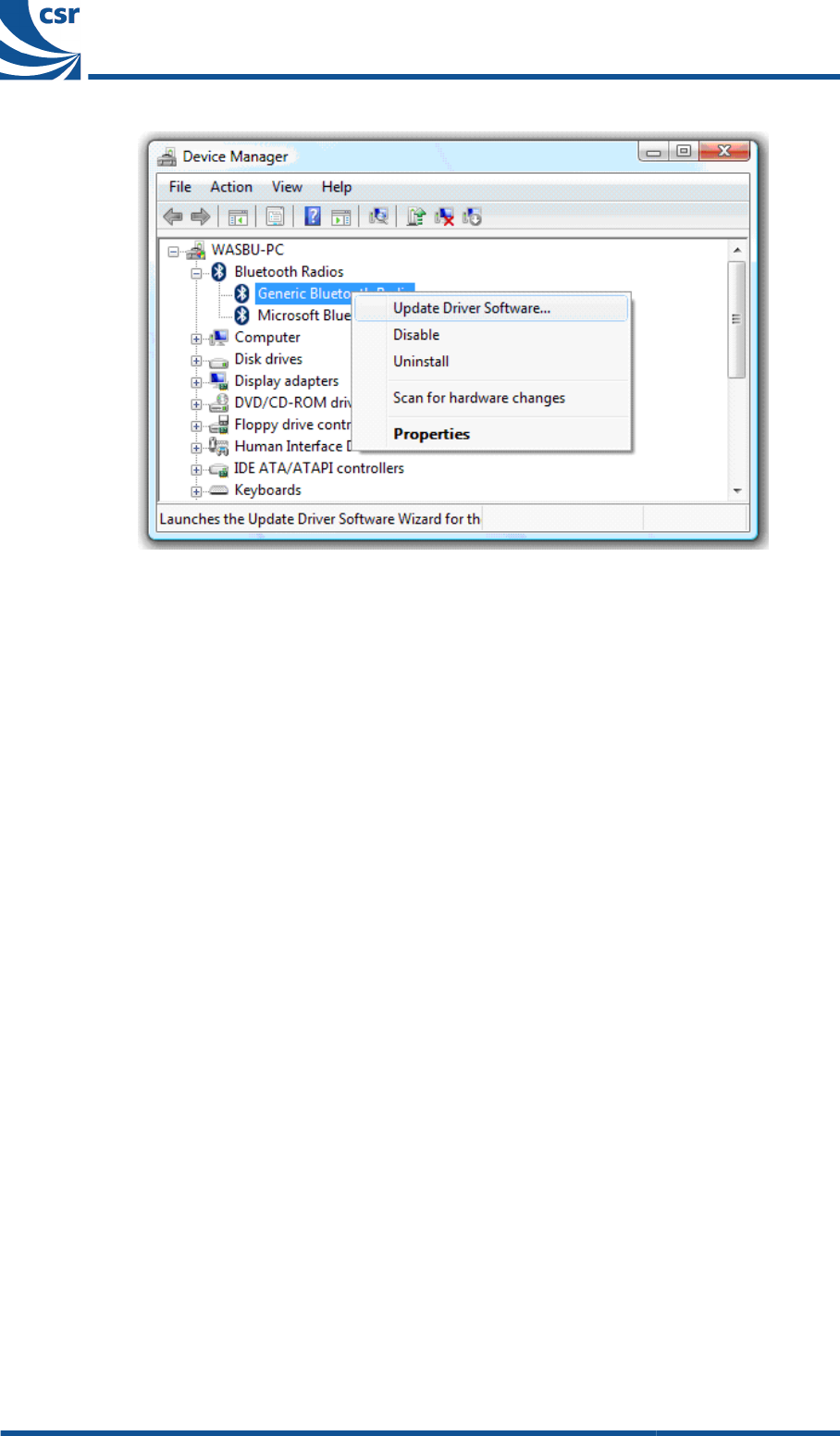
Figure 4.1: Changing the Driver
5. Complete the
Hardware Update Wizard
:
For Vista:
5.1
Browse my computer
5.2
Let me pick from a list of devices to install
5.3
Have disk
5.4
Browse
and navigate to the
Drivers
folder installed as part of BlueSuite and select
CSRBlueCoreUSB
. Click
Next
For XP:
5.1
No, not this time
5.2
Install from a list or specified location (Advanced)
5.3 Select
Search for the best driver in these locations
, tick
Include this location in the search
, then
Browse
and
navigate to the
drivers
folder installed as sub-directory of BlueSuite. Click
Next
6.
CSR BlueCore Controller
should now appear in the list of
Universal serial Bus Controllers
CSR recommends using PSTool via USB to check that communications can be successfully established.
Install a USB Driver
CS-118613-UGP3 © Cambridge Silicon Radio Limited 2000-2008
This material is subject to CSR’s non-disclosure agreement Page 12 of 27
_äìÉ`çêÉ
∆
=_äìÉpìáíÉ» User Guide

5 Firmware Overview
CSR’s BlueCore ICs contain control software (called firmware). Firmware in BlueCores with flash can be updated
using tools in BlueSuite:
■BlueFlash
(see Section 7.2) is used during development to update your BlueCore's firmware using the Serial
Peripheral Interface (SPI) debugging interface.
TestFlash
(part of
TrueTest
, see Section 8) can be used for
the same purpose on the production line.
■DFUWizard
(see Section 7.11) can sometimes be used to upgrade the firmware both in development and in
the field.
DFU (Device Firmware Upgrade) is a USB standard that allows end users to upgrade the BlueCore's
firmware over the USB or UART (Universal Asynchronous Receiver Transmitter) interface.
DFUWizard requires some firmware (the loader) to already be present in the device. The loader can only
be updated by BlueFlash.
The firmware version number is an important piece of information. You can identify your current firmware version
using BlueFlash, see Section 7.2.
5.1 Firmware File Formats
Table 5.1 describes the different firmware file formats you may encounter.
File Extension(s) Description
.xpv/.xdv
The standard BlueCore firmware file format holds the
binary data for firmware releases in two separate files,
each of which hold part of the data.
.xuv
This firmware file format is one file containing the
contents of both the
.xpv
file and the
.xdv
file.
.xhv
Chips with integrated flash have firmware files
containing extra production information about the flash.
.dfu
File format for use with
DFUWizard
.
Note:
DFUTools
, see Section 7.14, can convert
.xpv
and
.xdv
files into a
.dfu
file.
Table 5.1: Firmware File Formats
The
.dfu
file format is a flexible container format that can hold multiple different firmware images (for BlueCore2
and later chips) and multiple versions of the Persistent Store. This means you can have a universal
.dfu
file that
works for multiple hardware devices.
See
BlueCore Device Firmware Upgrade Overview
for a description of what DFU is and how it is used.
5.2 Persistent Store
As well as containing the firmware image (i.e. control software), firmware files can also contain configuration
information known as Persistent Store (PS). DFU files can contain information for a partial or full update of the PS.
Any areas of the PS that are not in the DFU file will remain as they were before the update. Other firmware files
cannot contain partial information; they either preserve or replace the PS.
Firmware upgrades from the CSR support website do not contain any PS settings, thus the current settings are
preserved. Firmware dumps that you make contain PS settings, and so will overwrite any existing ones if you upgrade
using a previously dumped file.
Firmware Overview
CS-118613-UGP3 © Cambridge Silicon Radio Limited 2000-2008
This material is subject to CSR’s non-disclosure agreement Page 13 of 27
_äìÉ`çêÉ
∆
=_äìÉpìáíÉ» User Guide

Note:
If firmware with no PS is downloaded onto a blank flash, a new PS is created on the flash memory using default
values suitable for a Casira module. However, some keys require calibration per module for optimal
performance.
See
pskeys.html
in the firmware release for details on using individual PS Keys. Some of the same
information is available by clicking the
Describe
button in
PSTool
, see the
PSTool User Guide
.
5.3 Firmware Build Types
The Bluecore’s Bluetooth stack firmware comes in two forms, either containing the Bluetooth stack layers up to the
Host Controller Interface (HCI) layer, or containing all the stack layers up to the Radio Frequency COMMunication
(RFCOMM) layer.
Since Firmware version 18, firmware builds are called Unified. They contain all the Bluetooth stack layers up to
RFCOMM, but can be configured to present either an HCI interface, or an RFCOMM interface. The behaviour is
controlled by
PSKEY_ONCHIP_HCI_CLIENT
, see the firmware release files for more information.
All types of firmware builds can be held in any BlueCore firmware file format.
5.4 Upgrading Firmware
Go to the Bluetooth Firmware section on the CSR support website (www.csrsupport.com/BluetoothFirmware) to get
the latest BlueCore firmware files. Use
BlueFlash
or
DFUWizard
to download the firmware to your BlueCore device.
Note:
Casira users should see the
Casira User Guide
for instructions on upgrading their firmware.
Firmware Overview
CS-118613-UGP3 © Cambridge Silicon Radio Limited 2000-2008
This material is subject to CSR’s non-disclosure agreement Page 14 of 27
_äìÉ`çêÉ
∆
=_äìÉpìáíÉ» User Guide

6 Getting Started
When you have connected your BlueCore device(s) to your computer, you can use BlueSuite tools to communicate
with them.
To test you have connected your BlueCore device(s) succesfully, you can use:
■
The command-line tool btcli (Section 7.5).
■
One of the graphical programs PSTool (See the
PSTool User Guide
) or BlueTest3 (See the
BlueTest User
Guide
).
6.1 Exploring the Bluetooth Stack
Use btcli if you want to explore the Bluetooth stack at all before starting development, as it provides a lower-level
interface than the graphical programs in BlueSuite.
The Bluetooth stack is described in the
Specification of the Bluetooth System
from www.bluetooth.com.
Getting Started
CS-118613-UGP3 © Cambridge Silicon Radio Limited 2000-2008
This material is subject to CSR’s non-disclosure agreement Page 15 of 27
_äìÉ`çêÉ
∆
=_äìÉpìáíÉ» User Guide

7 BlueSuite Programs
This chapter describes the programs included in BlueSuite. The features of each program are briefly described and
any relevant documentation is listed. Some programs without separate user guides are described in full detail.
7.1 Transport Options for Command Line Tools
Some command line tools in BlueSuite take a
-trans
option, which controls the transport options. Table 7.1
indicates which variables can be used with each tool:
Variable e2bluecmd/
blueflashcmd
pscli Default Description Example Values
CSRTRANS - x SPI The transport to use
SPI
,
USB
,
BCSP
,
H4
and
H5
HCIPORT - x autodetect if
USB, otherwise
COM1
The port to use for the
selected HCI transport if
not
CSRTRANS=SPI
com1
,
com2
,
csr0
HCIBAUD - x 115200 The baud rate to use for
uart based HCI
transports
115200
,
38400
, etc.
SPITRANS x x LPT The SPI transport to use
if
CSRTRANS=SPI
LPT
,
USB
SPIPORT x x autodetect The port to use for the
selected SPI transport
■
A LPT port number:
1
,
2
etc.
■
A USB-to-SPI
converter's ordinal
position:
1
,
2
etc.
■
A USB-to-SPI
converter's serial
number (as printed
on the converter
e.g.
185920
)
SPIMUL x x 0 The device to use if the
SPI port is multiplexed
0
,
1
, etc.
Table 7.1: Command Line Transport Options
Note:
Where appropriate, BlueSuite tools attempts to prepend
\\.\
to a string in HCIPORT. For example the name
of a CSR USB device on WinXP is
\\.\csr0
; BlueSuite tools re-interpret
csr0
as
\\.\csr0
.
Examples
To use USB-SPI (where 185920 is the serial number printed on the USB-SPI):
-trans "CSRTRANS=SPI SPITRANS=USB SPIPORT=185920"
(or just
"SPITRANS=USB SPIPORT=185920"
)
To use BCSP on COM1 at 38.4 kbaud:
-trans "CSRTRANS=BCSP HCIPORT=com1 HCIBAUD=38400"
It is possible to set these as Windows environment variables, which are then used as the default setting for a variable
e.g.
"set SPITRANS=USB"
would change the default SPI transport from LPT-SPI to USB-SPI.
BlueSuite Programs
CS-118613-UGP3 © Cambridge Silicon Radio Limited 2000-2008
This material is subject to CSR’s non-disclosure agreement Page 16 of 27
_äìÉ`çêÉ
∆
=_äìÉpìáíÉ» User Guide
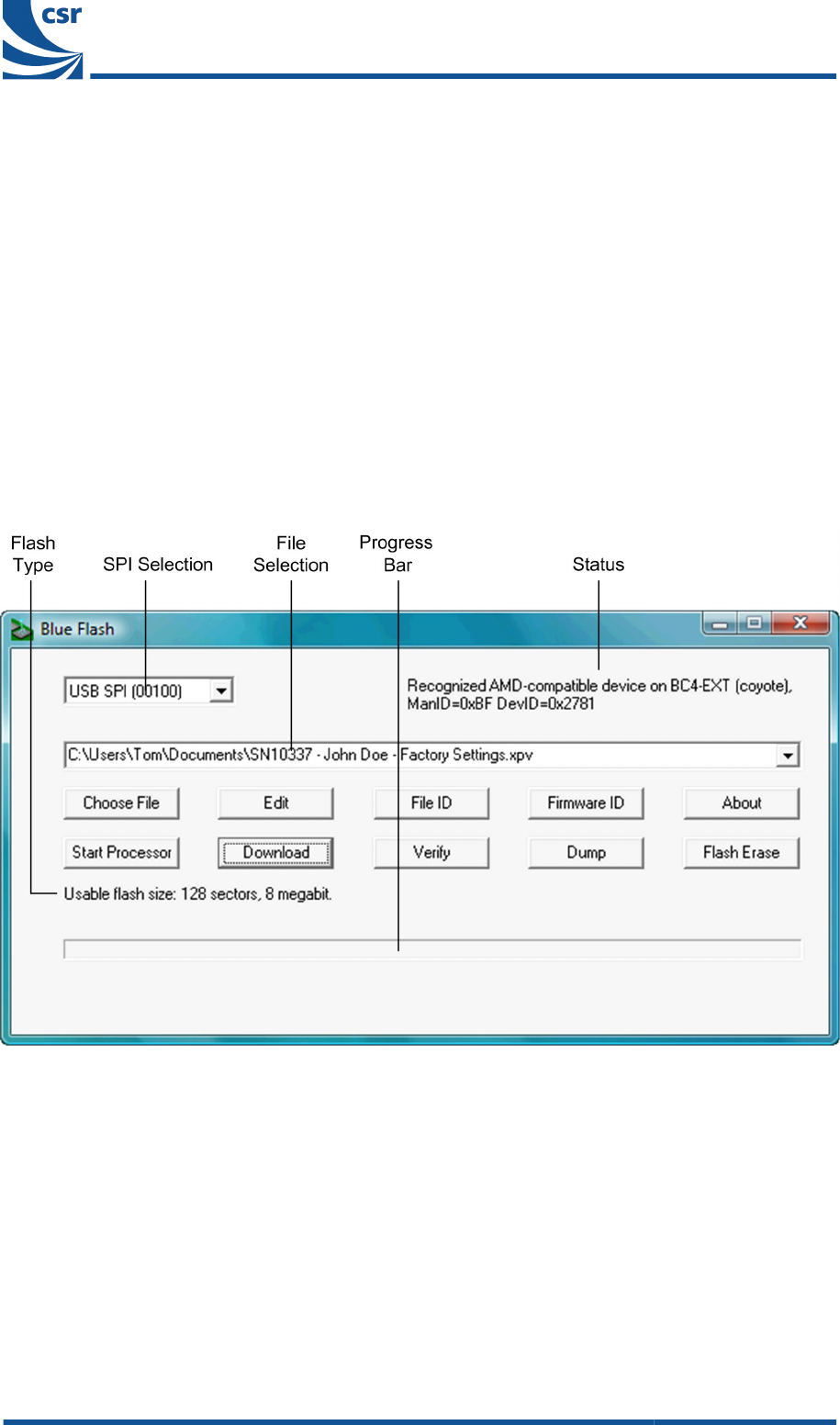
7.2 BlueFlash
BlueFlash is a utility that allows you to download and upload firmware to and from the flash memory on the Casira
modules or on your own BlueCore designs.
As described in Section 5, there are several different firmware file formats, and firmware files may contain Persistent
Store settings. Read Section 5.2 to make sure you do not accidentally change Persistent Store settings and to see
which parts of BlueCore's firmware is updated by BlueFlash.
Important Note:
Do not erase the Persistent Store with
Flash Erase
(either by selection or via
Full Erase
) unless you are completely
sure.
Fully erasing the flash removes all Persistent Store settings. Use
Full Erase
only in the event that there may be
a problem with the Persistent Store and you want to reload to a previous known working version.
7.2.1 User Interface
BlueFlash opens with a user interface window, see Figure 7.1.
Table 7.2 explains the function of each button or area.
Figure 7.1: BlueFlash User Interface in Windows Vista
BlueSuite Programs
CS-118613-UGP3 © Cambridge Silicon Radio Limited 2000-2008
This material is subject to CSR’s non-disclosure agreement Page 17 of 27
_äìÉ`çêÉ
∆
=_äìÉpìáíÉ» User Guide

Button or
Area
Explanation
Choose File
Opens a dialogue box for selection of the firmware file to download to the flash on the BlueCore
Module. You may open a
.xpv
,
.xuv
or
.xbv
firmware file
Note:
If you open a
.xpv
file, the
.xdv
file must be present in the same folder.
Edit
Opens a hexadecimal editing window. CSR recommends that you do not edit the
.xpv
file in any
way. If the code is edited, the Bluetooth protocol stack may behave erratically and it will no longer
be Bluetooth qualified.
Download
Copies the selected file to the flash on the BlueCore module. This process updates each flash block
as required and verifies them in turn.
Verify
Compares the selected file with the code programmed into the flash on the BlueCore module.
Verify
only compares components contained in the file. The status area shows any reported
differences.
Status Provides a text report of the status of the current download, upload or verify.
Progress
Bar
Displays a visual indication of progress for the current download, upload or verification.
Start
Processor
Changes depending on the status of the processor. If it says
Stop Processor
, the processor is running.
It must be stopped before attempting to download code. When the new code has been loaded, the
processor can be restarted by clicking
Start Processor
.
Firmware ID
Identifies which version of firmware is currently loaded on the module. BlueFlash does not identify
pre-Beta 10 firmware releases. If BlueFlash is unable to identify the firmware version, you can still
upgrade the firmware using this utility.
Dump
Allows the user to dump the contents of the flash on the BlueCore module to a file. The data can be
stored either as a pair of
.xpv
/
.xdv
files, as a combined
.xuv
file or as a raw binary file. The
dumped file also contains all of the Persistent Store settings, allowing you to restore to a known
firmware build and Persistent Store settings.
Flash Erase
Provides options for erasing some or all of the flash memory including the Persistent Store area.
File ID
Displays the name and version of firmware of the file selected for download on the module.
File
Selection
Displays the name and location of the file selected for download.
Flash Type Displays the type of flash memory that has been identified on the BlueCore module. Flash type is
identified after you stop the processor. Different types of flash memory may have different memory
block structures that require adjustments to BlueCore’s memory map. If the flash type indicates
Unrecognised Flash assuming SST
, either the flash on the BlueCore module is not
supported, or there is a problem with the SPI connection. See Section 7.2.2.
SPI
Selection
Allows the user to select the LPT or USB port to which the SPI cable is connected.
About
Indicates the version of the BlueFlash application in use. CSR advises using the most up to date
version. Refer to the CSR support website for available updates.
Table 7.2: Explanation of the BlueFlash User Interface
BlueSuite Programs
CS-118613-UGP3 © Cambridge Silicon Radio Limited 2000-2008
This material is subject to CSR’s non-disclosure agreement Page 18 of 27
_äìÉ`çêÉ
∆
=_äìÉpìáíÉ» User Guide

7.2.2 Troubleshooting BlueFlash
Potential problems:
■
If BlueFlash cannot identify the current build of firmware on BlueCore, check your firmware version.
BlueFlash does not identify pre-Beta 10 firmware releases.
■
If BlueFlash cannot identify flash type, BlueFlash fails to stop processor or BlueFlash times out trying to
make a connection to BlueCore, ensure that the following actions have been completed:
■
Run
InstParSpi.bat
(
C:\Program Files\CSR\BlueSuite\drivers
) to copy and
register the
parspi.sys
device driver. You need administrative rights to install the device driver on
a Windows XP, Windows 2000 system or Windows Vista. Reboot your PC.
■
Driver has been installed in the registry by looking for
HKEY_LOCAL_MACHINE\SYSTEM\CurrentControlSet\Services\Parspi
■
SPI cable is correctly connected
■
Check for conflicts with other drivers, especially printer drivers (this includes the PDF converters).
Conflicting printer drivers should be removed. To amend or remove a driver, go to
Start
/
Settings
/
Printers
. Right click for
Server Properties
. Click on the
Ports
tab. Move the port to another location or
delete the device.
■
Ensure that another SPI application is not trying to access the SPI port. SPI uses mutexes around port
access, therefore another application may lock the port. Close all SPI based applications (use Task
Manager if necessary) and retry. Reboot if necessary.
7.2.3 BlueFlashCmd
BlueFlashCmd is a command-line tool to download and upload firmware to flash memory on your BlueCore device.
It can do everything BlueFlash does.
Type
BlueFlashCmd.exe -help
for usage instructions.
Note:
Running BlueFlashCmd will reset your BlueCore chip
BlueSuite Programs
CS-118613-UGP3 © Cambridge Silicon Radio Limited 2000-2008
This material is subject to CSR’s non-disclosure agreement Page 19 of 27
_äìÉ`çêÉ
∆
=_äìÉpìáíÉ» User Guide

7.3 PSTool
PSTool is an editing suite that allows you to read and modify the Persistent Store. The Persistent Store consists of
configuration keys that modify the operation of the firmware. BlueCore is a very flexible device with many setup
options. PS Keys must be set correctly for BlueCore to work in a particular design. Some PS Keys must be calibrated
for each module.
7.3.1 PsCli
PsCli is a command-line interface for reading and modifying the Persistent Store. Type
pscli.exe -help
to
see usage instructions.
7.3.2 Documentation
PSTool and pscli are described in the
PSTool User Guide
.
See
pskeys.html
in the firmware release for details on using individual PS Keys.
7.4 BlueTest
BlueTest is a program that enables you to execute BlueCore’s Built In Self Test (BIST) functions for RF testing. The
BIST functions consist mainly of low level radio tests (transmitting a continuous wave at a prescribed frequency or
receiving pseudo random data and calculating bit error rates). Included are tests for the PCM port and other internal
blocks.
7.4.1 BlueTest3
BlueTest3 is a newer product which will replace BlueTest. Both programs support all of the currently relevant tests,
but only BlueTest3 can make debug interface connections over the
serial peripheral interface
(SPI) transport.
BlueTest is still distributed as it supports some older tests in firmware versions 22 and earlier that BlueTest3 does
not support.
Important Note:
CSR recommends using BlueTest3 unless you need features available only in BlueTest.
7.4.2 Documentation
See the
BlueTest User Guide
.
BlueSuite Programs
CS-118613-UGP3 © Cambridge Silicon Radio Limited 2000-2008
This material is subject to CSR’s non-disclosure agreement Page 20 of 27
_äìÉ`çêÉ
∆
=_äìÉpìáíÉ» User Guide

7.5 BTCli
Bluetooth Command Line Interface (BTCli) is a command-line program that lets you send Host Controller Interface
(HCI) commands to your BlueCore device. Host computers use the HCI interface (part of the Bluetooth specification)
to communicate with Bluetooth controllers (e.g. your BlueCore chip).
A basic user guide for BTCli is provided as a text file (
btcliug.txt
) in the BlueSuite directory.
To run BTCli, you can run it from the Start Menu and use the graphical dialogue to select a host interface , or you
can run it from the command-line.
To run it from the command-line, open a Command Prompt window and navigate to the BlueSuite directory. From
there, run BTCli with the appropriate arguments for the current host interface:
btcli <transport> <port> <baud rate>
7.5.1 Example Usage
Table 7.3 shows some examples:
Desired Connection Command Line
BCSP on COM port 1 at 115.2 kbaud
btcli bcsp com1 115200
H4 on COM port 3 at 38.4 kbaud
btcli h4 com3 38400
USB (No data rate is required)
btcli usb csr0
or
btcli usb BTWUSB_0
Table 7.3: Example Connections and How to Make Them with BTCli
The most common use for BTCli is to activate Inquiry/Page Scan and allow the module to accept over air test
commands from an automated tester. With BTCli this is very simple, involving only two commands:
slave
(which
activates the scan mode and enables auto accept of connections) and
edutm
(
enable device under test mode
). A
printout from BTCli carrying out these commands is shown below. Text entered by the user is shown emphasised.
C:\Program Files\CSR\BlueSuite>btcli.exe usb csr0
Version 2.0
Copyright (C) 2000-2008 Cambridge Silicon Radio Ltd.; all rights reserved
usb on csr0 at 12000000 bps
slave
sef connection_setup all auto_accept
wse inquiry_page
rba
command_complete nhcp:0x01 set_event_filter success
command_complete nhcp:0x01 write_scan_enable success
command_complete nhcp:0x01 read_bd_addr success ba:0x00025b02164c
edutm
command_complete nhcp:0x01 enable_device_under_test_mode success
7.6 RFCli
RFCli is a command line utility for communicating with RFCOMM firmware builds. It enables you to send and receive
RFCOMM primitives to the chip (as well as other protocols). It also has a Tool Command Language (TCL) interpreter
built in so you can write scripts.
See
rfcli.html
for a quick introduction, and
rfcli.txt
for full documentation.
BlueSuite Programs
CS-118613-UGP3 © Cambridge Silicon Radio Limited 2000-2008
This material is subject to CSR’s non-disclosure agreement Page 21 of 27
_äìÉ`çêÉ
∆
=_äìÉpìáíÉ» User Guide

7.7 BCFMRadio
Important Note:
Read the document referenced below before running this program, as you must configure your BlueCore device
before this program will connect to it.
BCFMRadio is a graphical tool for exercising the FM receiver on Bluecore5-FM. It is able to communicate with the
Bluecore using I
2
C or BCCMDs using BCSP, H4, H4 Deep Sleep, H5, USB and SPI. BCFMRadio provides a user-
friendly interface allowing configuration of the BlueCore5-FM radio.
See
Operating the BlueCore5-FM Radio Application Note
.
7.8 BCFMCli
Important Note:
Read the document referenced below before running this program, as you must configure your BlueCore device
before this program will connect to it.
BCFMCli is a command line application for controlling the FM receiver on Bluecore5-FM. It is able to communicate
with the Bluecore using I
2
C or BCCMD with SPI over an LPT port.
Type
help
from within BCFMCli for usage instructions.
See
Operating the BlueCore5-FM Radio Application Note
.
7.9 E2Util
Note:
E2BlueCmd (Section 7.10) will replace E2Util. E2Util is deprecated and may not be included in future releases.
E2Util is a command-line tool to do basic operations on an I
2
C EEPROM like dumping the EEPROM's raw contents,
clearing it, and programming it.
E2Util controls your BlueCore chip over SPI, and does not require running firmware.
Type
e2util -help
for usage instructions.
7.10 E2BlueCmd
E2BlueCmd is a new command-line tool which replaces E2Util. E2BlueCmd performs EEPROM device operations
using a boot program running on BlueCore. This approach makes it faster than E2Util, and provides support for gang
programming operations using the CSR gang programmer hardware. As well as dumping and writing files, it can
write the BlueCore EEPROM header, read and write blocks, and verify EEPROM contents against a file.
E2BlueCmd works over the SPI interface.
Type
e2bluecmd -help
for usage instructions.
7.10.1 EEPROM File Formats
E2BlueCmd saves EEPROM files in a different format to those saved by E2Util, and should only be loaded back to
EEPROM with E2BlueCmd.
Files saved by E2Util can be loaded back to EEPROM with E2Util or E2BlueCmd.
BlueSuite Programs
CS-118613-UGP3 © Cambridge Silicon Radio Limited 2000-2008
This material is subject to CSR’s non-disclosure agreement Page 22 of 27
_äìÉ`çêÉ
∆
=_äìÉpìáíÉ» User Guide

7.11 DFU Wizard
The DFU Wizard is a program for end users to upgrade the firmware on their BlueCore devices. The upgrade process
is documented in the
BlueCore Device Firmware Upgrade (DFU) Overview
.
7.12 DFU Babel
The USB to SPI Converter (or Babel) contains a BlueCore3-Multimedia chip with special firmware that transforms
the USB packets from the host computer to SPI signals sent out over Category 5 cable.
DFU Babel is a program that lets you upgrade your USB to SPI Converter with new firmware. If CSR release a
firmware upgrade for the USB to SPI Converter, you will be able to find it on www.csrsupport.com.
See the
USB-SPI Converter User Guide
.
7.12.1 Upgrading The USB to SPI Converter Firmware
Important Note:
Do not attempt to upgrade a USB to SPI Converter with firmware designed for different hardware (e.g. Casira
firmware). The USB to SPI Converter needs special firmware and any other firmware may make it permanently
unusable.
To upgrade the firmware on your USB to SPI Converter:
1. Connect the USB to SPI Converter to the host computer. You do not need to connect the converter to a
BlueCore module.
2. Run DFU Babel from the Start Menu. Alternatively run
dfubabel.exe
from the command-line. For
command-line usage type
dfubabel.exe -help
.
3. Your USB to SPI Converter is now in DFU mode. You may have to manually load the DFU mode device
driver for it. This driver is installed by
CSRBlueCoreUSB.inf
as before. While your device is in DFU
mode, it appears to be a normal BlueCore3-Multimedia device attached over USB.
4. Follow the instructions in the DFU Wizard to upgrade the firmware on your USB to SPI Converter.
5. Reset your USB to SPI Converter to exit DFU mode and start the new firmware. Unplug it and plug it back
in.
BlueSuite Programs
CS-118613-UGP3 © Cambridge Silicon Radio Limited 2000-2008
This material is subject to CSR’s non-disclosure agreement Page 23 of 27
_äìÉ`çêÉ
∆
=_äìÉpìáíÉ» User Guide
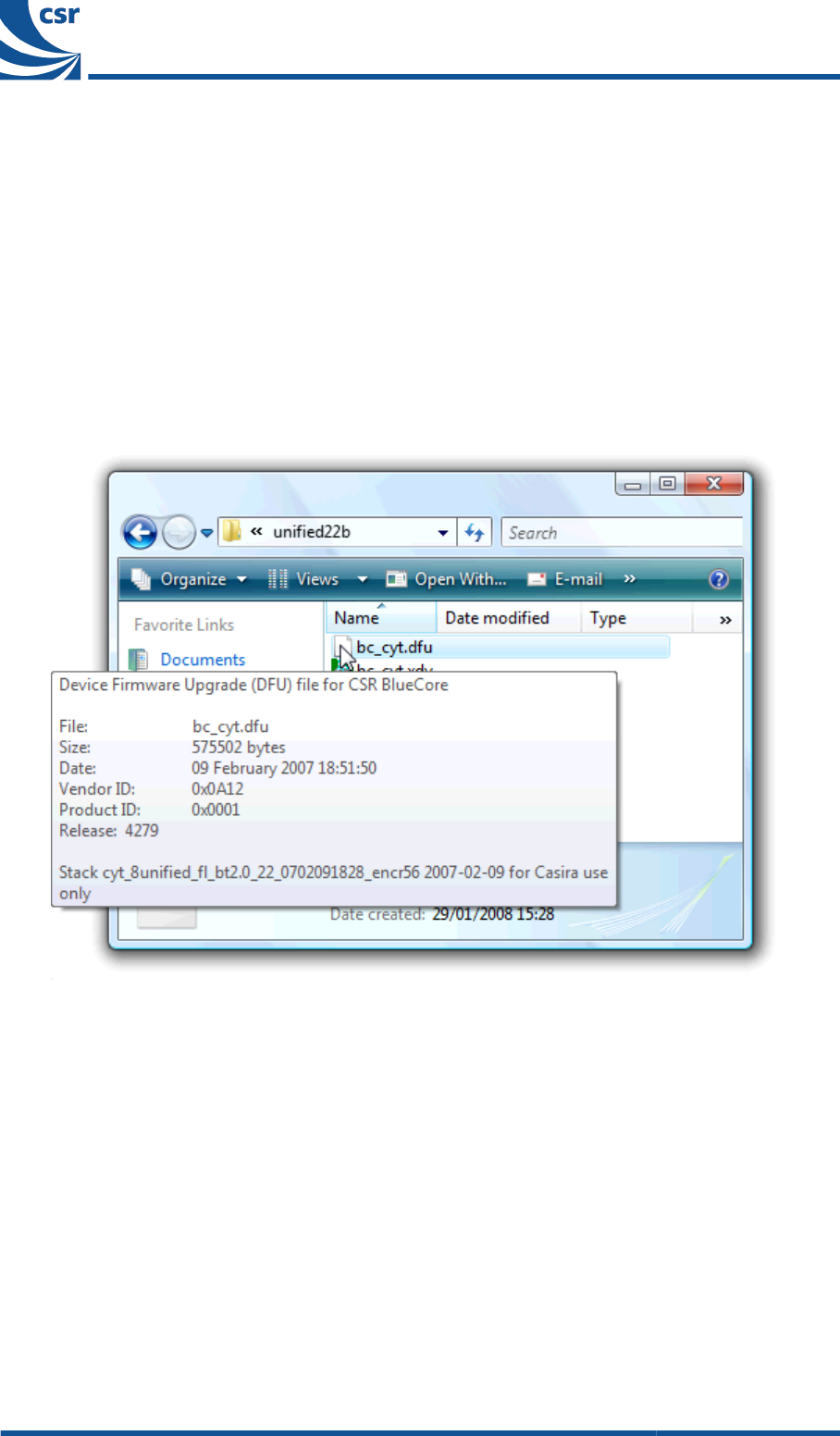
7.13 DFU ToolTips
BlueSuite comes with DFU ToolTips, a shell extension that shows tool tips for DFU files in Windows. To see the tool
tip, point the mouse over a DFU file, and wait for the tool tip to appear. Figure 7.2 shows a DFU tool tip.
If the tool tip does not appear, you may have disabled tool tips in your version of Windows. To enable tool tips for
files:
1. Go to the
Control Panel
2. Open
Folder Options
3. Select the
View
tab
4. Scroll down the Advanced settings to
Show pop-up description for folder and desktop items
. Tick this box.
5. Click
OK
DFU ToolTips also lets you right-click on a DFU file, and
Download to BlueCore
. This runs the DFU Wizard to download
the DFU file to your BlueCore device.
Figure 7.2: A DFU ToolTip
7.14 DFU Tools
DFU Tools are a suite of command-line tools to let your sign and combine firmware and persistent store files to form
DFU files.
The DFU Tools documentation can be accessed from the Start Menu. Open the
CSR BlueSuite
item, and click
CSR
DFU Tools Documentation
.
BlueSuite Programs
CS-118613-UGP3 © Cambridge Silicon Radio Limited 2000-2008
This material is subject to CSR’s non-disclosure agreement Page 24 of 27
_äìÉ`çêÉ
∆
=_äìÉpìáíÉ» User Guide

8 TrueTest Toolkit
The TrueTest toolkit consists of the necessary libraries and documentation to let you develop applications in a variety
of languages for production programming and testing of BlueCore enabled devices.
The toolkit is designed for use in production test systems. Instead of writing test scripts to call other BlueSuite
programs, you can write a test program that accesses the test APIs (
Application Programming Interface
) directly.
See the
TrueTest Toolkit Introduction
.
TrueTest Toolkit
CS-118613-UGP3 © Cambridge Silicon Radio Limited 2000-2008
This material is subject to CSR’s non-disclosure agreement Page 25 of 27
_äìÉ`çêÉ
∆
=_äìÉpìáíÉ» User Guide
Regulatory Notes & Information
This device complies with Part 15 of the FCC Rules.
Operation is subject to the two following conditions :-
(1) This device may not cause harmful interference, and
(2) This device must accept any interference received, including interference that may
cause undesired operation.
Changes or modifications to the transmitter not expressively approved by CSR could void
the authority ability to operate the equipment.
User Label Warning !
The transmitter is in compliance with the Part 15 FCC Rules. A label which demonstrates
compliance with the FCC is located on the bottom of the laptop.
The label contains the following information :-
Contains FCC ID:- PIWBSMAN
Transmitter Warning !
Installers of the Bluetooth transmitter should note that the Bluetooth transmitter should not
be co-located with any other transmitter, for example WLAN interfaces in the lap top.
The distance between the Bluetooth transmitter and antennas of other radio equipment
must be at least 20cm in distance away from each other. Any closer installations require additional
certification filings to examine co-location issues.

9 Document References
Document Reference
Specification of the Bluetooth System
Version 2.1 + EDR, Core Package, 26 July 2007
www.bluetooth.com
BlueCore Class 2 Example Designs www.csrsupport.com
BlueCore Production Information Data Books www.csrsupport.com
BlueCore Device Firmware Upgrade (DFU) Overview
CS-112861-AN
USB Device Firmware Upgrade Specification
Part of the USB Specification
http://www.usb.org/developers/devclass_docs/
DFU_1.1.pdf
Device Firmware Upgrade Protocol Specification
CS-102656-SP
Device Firmware Upgrade File Format Specification
CS-113166-AN
PSTool User Guide
CS-101505-UG
BlueTest User Guide
CS-102736-AN
Operating the BlueCore5-FM Radio
CS-113378-AN
USB-SPI Converter User Guide
CS-114776-UG
TrueTest Toolkit Introduction
CS-101531-AN
Casira User Guide
CS-102077-UG
Document References
CS-118613-UGP3 © Cambridge Silicon Radio Limited 2000-2008
This material is subject to CSR’s non-disclosure agreement Page 26 of 27
_äìÉ`çêÉ
∆
=_äìÉpìáíÉ» User Guide

Terms and Definitions
Term Definition
API Application Programming Interface
BlueCore
®
Group term for CSR’s range of Bluetooth wireless technology ICs
Bluetooth
®
Set of technologies providing audio and data transfer over short-range radio connections
BTCli Bluetooth Command Line Interface
CD ROM Compact Disk Read Only Memory
CSR Cambridge Silicon Radio
DFU Device Firmware Upgrade
DLL Dynamically Linked Library
HCI Host Controller Interface
IC Integrated Circuit
i.e.
Id est
, that is
INF Setup Information File, often used for Windows device drivers
Persistent Store Store of configuration values in non-volatile memory
PID Product ID used to identify USB devices
PsCli Persistent Store Command Line Interface
RAM Random Access Memory
RfCli RFCOMM Command Line Interface
RFCOMM Protocol layer providing serial port emulation over L2CAP; element of Bluetooth
SPI Serial Peripheral Interface
UART Universal Asynchronous Receiver Transmitter
USB Universal Serial Bus
VID Vendor ID used to identify USB devices
Terms and Definitions
CS-118613-UGP3 © Cambridge Silicon Radio Limited 2000-2008
This material is subject to CSR’s non-disclosure agreement Page 27 of 27
_äìÉ`çêÉ
∆
=_äìÉpìáíÉ» User Guide